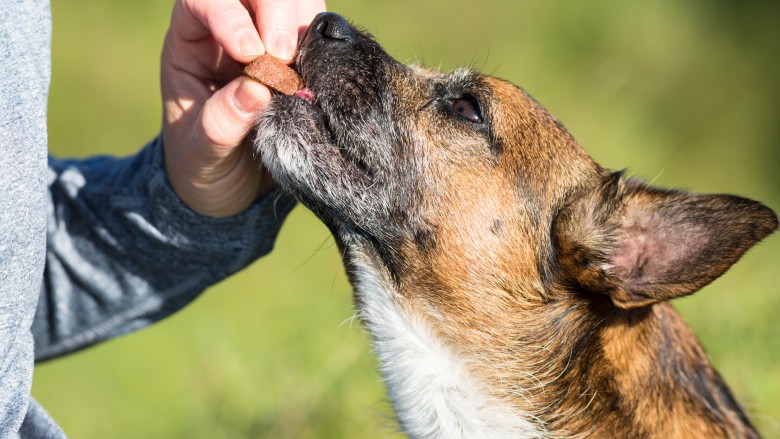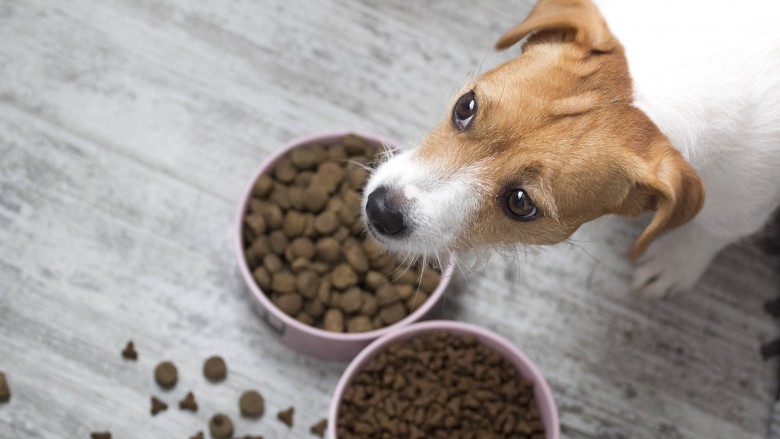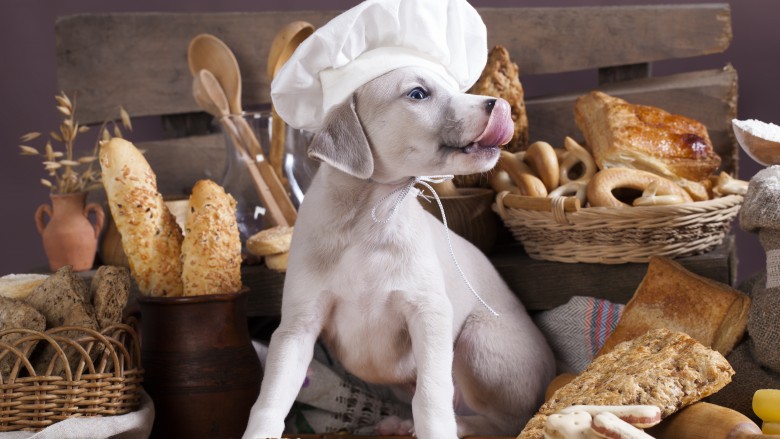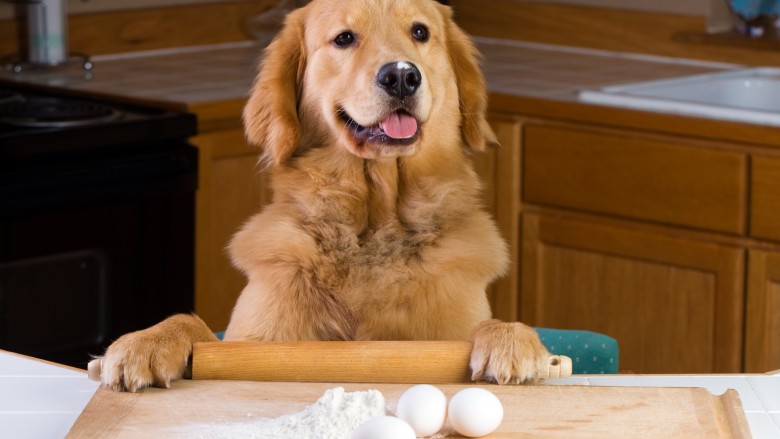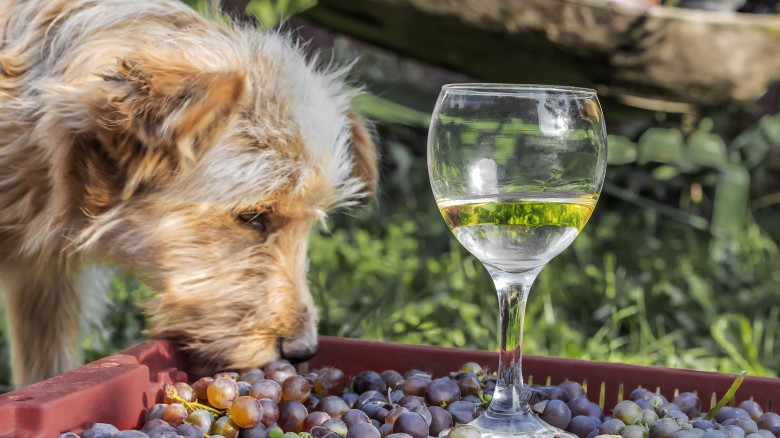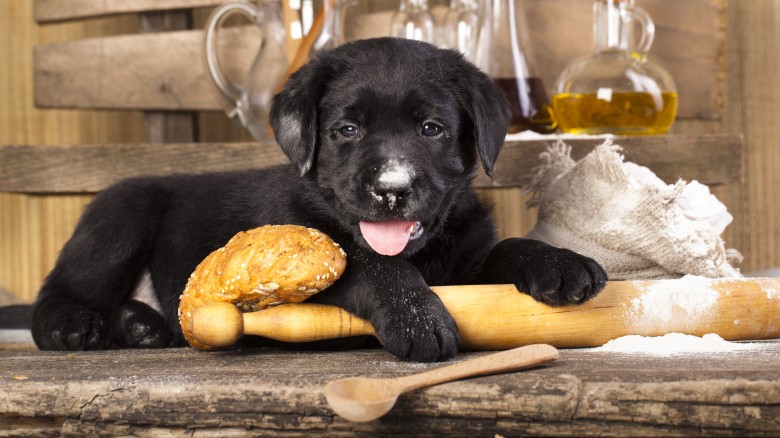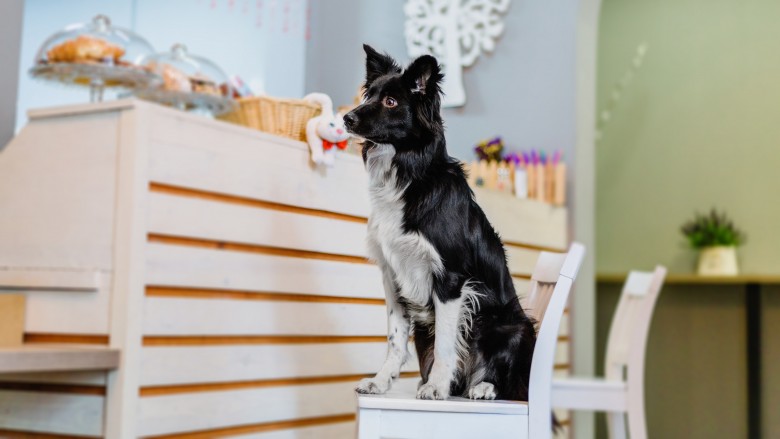What You Need To Know Before Making Your Own Dog Treats
Our dogs are our best friends, and that meme that's been floating around for a long time is the absolute truth: whoever said diamonds are a girl's best friend never had a dog.
We know how much they love us, and making your own treats for your canine friend is a great way to show them just how much you love them, too. Not only is it easier than you think, but it's great fun to hang out in the kitchen, whip up a batch of treats, and see the eager happiness on their faces when they realize that it's all for them.
When I first started making my two dogs their own treats, it was a little bit of trial and error, so here's some tips, tricks, and some guidance from a nutritionist to help you skip the trial and get right to the fun!
Why it's a good idea
It might be easy to pick up a box of biscuits at the grocery store, but think of it as the difference between a batch of homemade, chocolate chip cookies and a package you grabbed at the convenience store. Not only are homemade treats going to taste better (and I've tried more than I want to admit), they're going to be healthier, too.
I reached out to Jessica Young, a nutritionist over at The Missing Link, for some official input about what it is that makes most grocery store dog treats a bad idea. She says that it's a combination of things, and that a lot of our concerns over what we eat extend to our pups as well.
"It's less about what's missing and more about the process in which most shelf stable commercial pet food is made," she said. "Like in human food, overly processed foods (ones that are cooked at a high temperature) kill the nutrients no matter the quality. We wouldn't be able to eat the same dry, processed food — think power bars — every day and thrive."
Commercial ingredients aren't great, either
When my dogs were pups, my vet recommended plain pumpkin and white meat chicken for their baby digestive tracts that were painfully sensitive. Finding a commercial food that agreed with them was next to impossible, but things improved considerably for them once I gave up looking and just started picking up cans of pumpkin at the grocery store to make their own snacks. According to Young, there's all kinds of things in foods that are even labeled "grain-free" that can be causing all kinds of discomfort for your dog.
"Most commercial pet foods tend to have higher amounts of wheat, grains, or starch fillers," she says. "Even grain-free foods just replace wheat with potato, and that's not great for your pet."
They're also filled with things like sugar and corn syrup, and those things aren't good for us or our pets. Just imagine getting a special treat from your favorite person in the whole world, and it's something that's not only not good for you, but it's going to make you feel bad, too. Who would want that?
Think outside the box when it comes to ingredients
So, you're going to be more careful when it comes to picking up a special treat for your pup, and this is where the fun starts. While some dogs are known for their ability and desire to eat anything, others can be pretty picky. I have one of each, and that means needing to cater to the tastes of a spoiled dog who is more than happy to spit something she doesn't like onto the floor, and heave a frustrated sigh as she looks up for something acceptable.
And that's meant getting creative, and one of the things I stumbled across in my search for fun recipes is the idea of using grains leftover from brewing in treats. Brilliant? Yes! If you're not a homebrewer, chances are good that you know someone who is. If that's not the case at all, there's breweries in your area that might be more than happy to give you a bucket of their used grains.
The American Homebrewers Association featured a story on Brew Dog Frank, who couldn't get enough of snacking on spent grains. That led them to come up with a recipe for Peanut Butter Banana Spent Grain Dog Treats, which is not only a great treat, but it's a great way to use what would otherwise be a waste product. But make sure you're not giving them hops, those are toxic — and more on that in a bit. Was it a win with Picky Dog? Absolutely!
Superfoods for dogs
Everyone knows that dogs love things like banana, peanut butter, and apples . . . except for my Picky Dog, who will only eat apples if they're not too sweet or too tart. I know, this is what I deal with! When I talked to Jessica Young, she brought up the idea of canine superfoods, and what better ingredients to include in your dog treats than superfoods?
The Missing Link has an entire line of products dedicated to superfoods that fill in the gaps — or rather, provide the missing link — between the nutrition your dog is getting from commercial foods and what they need to be happy and healthy. Some of them are pretty surprising, and you have some of them in your kitchen right now.
Blueberries, kelp, sweet potato, kale, eggs, flaxseed, carrots, fish and salmon oil, and apple cider vinegar are all The Missing Link's missing links, foods that provide valuable nutrients that your dog won't get from most commercial foods and treats. If part of that sounds a bit like the ingredient list for your morning smoothie, there's a good reason for that. Those things include nutrients that your dog needs, too, things like vitamins, potassium, calcium, fiber, and antioxidants. Keep that in mind when you're adapting your new go-to treat recipes, and you'll see a difference!
What not to include
You know that chocolate isn't good for dogs, but there's a whole list of things that can be anything from irritating to toxic and potentially deadly for your dog. Before you start making your own treats, it's vitally important to become familiar with the list, as most of these things are in your kitchen already.
Some foods, like sugar, salt, capsaicin, milk and other dairy products, can cause digestive issues that aren't fun for you or your dog. Foods that are poisonous to your dog include things like the infamous chocolate, coffee, apple seeds, macadamia nuts, onions, and chives, and onions are one of the worst things you can give your dog. If they get some of these kitchen staples, it can cause severe anemia.
While effects can depend on the size of your dog, there's some foods that are downright deadly. Grapes and raisins can cause kidney failure, liver damage, and only a handful can be potentially deadly. Xylitol is another big one, and it's found in a range of things from gum to bread and pastries. This one can cause seizures, low blood sugar, and liver failure in small doses, and it can also kill. Making your own treats should be something fun, and knowing just what could hurt your pup is so important. That's only a partial list, and there's more to be found on The Canine Journal and other places across the internet.
Adapt your favorite recipe for a treat you can share
My dogs are high-energy, high-maintenance, and demanding—and I love them to bits. Since the only way to get a bit of peace and quiet is to wear them out completely, that means heading out on hikes is some of the most fun we can have. We always take a few water bottles, and as an added bonus, a little baggie of treats.
It wasn't long before I stumbled on the idea of adapting an energy and protein bar recipe into something that we can all enjoy! There's a huge number of energy bar recipes out there, and our go-to favorite is this one from Bowl of Delicious. Since bananas are a win with both dogs and peanut butter is a given, it's something they both love.
Even though it calls for nuts and seeds, I just give leave those out in favor of some extra oats, and then bake into bars that are a great snack for when we get wherever we're going. Once you start experimenting, you'll find that there's no reason your afternoon baking project is one that's only for your pups!
Get creative with how you bake
There's a ton of bone-shaped silicone molds out there, but if you're pretty sure you don't have room in your kitchen for more molds, you're definitely not alone. We have a super-tiny kitchen and a super-tiny oven to match, and that's meant getting a bit creative with what we have around the house. Making your own dog treats should, by no means, mean shopping for extra things if you don't have to, and we're huge fans of repurpose and reuse!
There's a few things we've found make baking and cooking your treats easier. A lot of recipes will have you rolling out treats to cut, re-roll, cut again, and that can all turn into a huge time investment. Instead, pull out your mini muffin tins, and use that to portion out the dough into sections that are perfectly bite-sized for most dogs. If it's a firm dough, you can also use a cookie sheet covered with baking paper. Just spread out the dough and score it with the back of a knife. Once the treats are baked, you can break them along the score marks for easy portioning that's not going to mess up the kitchen any more than you have to.
In some cases, you might want something that looks a little more professional. Going to a party? Bring along a gift bag of treats for the host's dog! Depending on the size of the dog, there's all kinds of things you can use — bottle caps, shot glasses, and tea light containers all make great cookie cutters if you're in a pinch.
Use your slow cooker
Daily life is busy, and let's face it, sometimes there's not enough hours in the day for what you already have on your plate, much less adding in extra time to essentially bake a batch of cookies. If that's the case, there's a handy little tool in your kitchen that's going to make this a whole lot easier: your slow cooker!
Our super-tiny oven means that if there's one thing already in there, there's nothing else that's going to fit. And since I'm a huge fan of multitasking, the afternoon I'm already in the kitchen is the perfect time to make a fresh batch of cookies for the dogs. If you opt to go the slow cooker route, you're cutting out all the time you're going to spend rolling out and cutting treats, and even though it's going to take longer to cook, you can literally mix up a batch and then forget about it.
One of the best recipes we've found for slow cookers is this one for personalized baked oatmeal bars from Sugar Free Mom. The base of the bars is a super-healthy (and, of course, sugar-free) banana, eggs, flaxseed, and oats, and you'll notice some of those are on Young's list of canine superfoods. Win! They can be topped with anything you like, and once the batter's mixed up and poured into a parchment-paper lined crockpot, you can turn it on low and forget about it for the next eight hours. There's nothing I don't like about this, and it's easy enough that you can stir up a batch in the morning, leave it on all day, and come home to a tasty treat you can share with your best friend—who's been waiting for you all day.
It's not as challenging as you might think
The best thing about making your dogs their own treats is when they realize it's all for them. By now, mine completely understand what's going on when I tell them it's time to put on their (figurative) Baker Dog Hats, and seeing them peering into the oven as if they're trying to see how long of a wait they have never, ever gets old. They're not just my dogs, they're my kids—right down to patiently waiting to lick the bowls and the spoon. That's a special relationship, and making your own dog treats is an easy way to go an extra mile for a bit of bonding with your dog.
There's no reason at all to restrict yourself to the mass-produced, commercial treats that line the shelves of your grocery store, full of enough preservatives that they're good for months if not years. Not only is it quick and easy, but it's as simple or as complicated as you want to make it. It's easy to whip up a batch to cook alongside dinner, or just if you're in the kitchen anyway, and best of all, your best friend is going to love you even more for it, if that's even possible.

